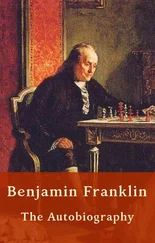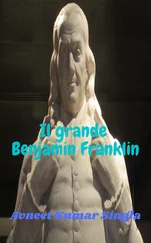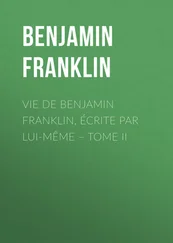We had a watchman placed in the bow, to whom they often called, “Look well out before there;” and he answered, “Ay, ay”; but perhaps had his eyes shut, and was half asleep at the time; they sometimes answering, as is said, mechanically; for he did not see a light just before us, which had been hid by the studding-sails from the man at the helm, and from the rest of the watch, but by an accidental yaw of the ship was discovered, and occasioned a great alarm, we being very near it: the light appearing to me as large as a cartwheel. It was midnight, and our captain fast asleep; but Captain Kennedy, jumping upon deck, and seeing the danger, ordered the ship to wear round, all sails standing; an operation dangerous to the masts, but it carried us clear, and we avoided shipwreck, for we were running fast on the rocks, on which the light was erected. This deliverance impressed me strongly with the utility of lighthouses, and made me resolve to encourage the building more of them in America if I should live to return thither.
In the morning it was found by the soundings that we were near our port, but a thick fog hid the land from our sight. About nine o’clock the fog began to rise, and seemed to be lifted up from the water like the curtain of a theatre, discovering underneath the town of Falmouth, the vessels in the harbour, and the fields that surround it. This was a pleasing spectacle to those who had been long without any other prospect than the uniform view of a vacant ocean, and it gave us the more pleasure, as we were now free from the anxieties which had arisen. [13]
I set out immediately with my son for London, and we only stopped a little by the way to view Stonehenge on Salisbury Plain, and Lord Pembroke’s house and gardens, with the very curious antiquities, at Wilton. We arrived in London, the 27th of July, 1757. [14]
Perhaps from the time, when the name of Franklin, which before was the name of an order of people, was assumed by them for a surname, when others took surnames, all over the kingdom.
As a proof that Franklin was anciently the common name of an order or rank in England, see Judge Fortesue, De laudibus Legum Anglia, written about the year 1412, in which is the following passage, to show that good juries might easily be formed in any part of England—
“Moreover, the same country is so filled and replenished with landed menne, that therein so small a Thorpe cannot be found wherein dwelleth not a knight, an esquire. or such a householder, as is there commonly called a Franklin, enriched with great possessions; and also other freeholders, and many yeomen able for their livelihoods to make a jury in form aforementioned.”— Old Translation.
Chaucer, too, calls his Country Gentleman a Franklin, and, after describing his good housekeeping, thus characterizes him—
“This worthy Franklin bore a purse of silk,
Fixed to his girdle, white as morning milk.
Knight of the Shire, first Justice at th’ Assize,
To help the poor, the doubtful to advise.
In all employments, generous, just, he proved;
Renowned for courtesy, by all beloved.”
Again— —
“A spacious court they see,
But plain and pleasant to be walked in
Where them does meet a Franklin fair and free.”
SPENSER’S
Faery Queen.
This grandson of Benjamin Franklin followed the trade of his father, which was that of a cutler. On the father’s sign, suspended over the shop door, was painted a crown. with his name, “Samuel Franklin, from London.” It had also some of the implements of his trade. This sign was retained by Samuel Franklin the younger. At the begin. ning of the Revolution, the “Sons of Liberty” took offence at this crown, and demanded the removal of the sign; but they finally contented themselves with daubing a coat of paint over the crown, leaving “Samuel Franklin, from London,” and the implements of cutlery. Time gradually wore off the paint from the crown, so as to make it faintly visible; and Mather Byles, who was noted for his loyalty as for his puns, used to lament to Mrs. Franklin, that she should live at the sign of the half-crown.
He was born January 6th, 1706, Old Style, being Sunday, and the same as January 17th, New Style, which his biographers have usually mentioned as the day of his birth. By the records of the Old South Church in Boston, to which his father and mother belonged, It appears that he was baptized the same day. In the old public Register of Births, still preserved in the Mayor’s office in Boston. his birth is recorded under the date of January 6th, 1706 At this time his father occupied a house in Milk Street, opposite to the Old South Church, but he removed shortly afterwards to a house at the corner of Hanover and Union Streets, where it is believed he resided the remainder of his life, and where the son passed his early years.
In the island of Nantucket.
The poem, if such it may be called, of which these are the closing lines, extends through fourteen pages of a duodecimo pamphlet, entitled. “A Looking-Glass for the Times; or the former Spirit of New England revived in this generation; by PETER FOLOER.” It is dated at the end, “April 23rd, 1676.” The lines which immediately precede those quoted by Dr. Franklin, and which are necessary to complete the sentiment Intended to be conveyed by the author, are the following :—
“I am for peace and not for war,
And that’s the reason why
I write more plain than some men do,
That use to daub and lie.
But I shall cease, and set my name
To what I here insert,
Because to be a libeller,” &c.
The marble stone on which this inscription was en graved, having become decayed, and the inscription itse’f defaced by time, a more durable monument has been erected over the graves of the father and mother of Franklin. The suggestion was first made at a meeting of the building committee of the Bunker Hill Monument Association, in the autumn of 1826, and it met with universal approbation. A committee of management was organized, and an amount of money adequate to the object was soon contributed by the voluntary subscriptions of a large number of the citizens of Boston. The corner.stoue was laid on the 15th of June. 1827, and an address appropriate to the occasion was pronounced by General Henry A. S. Dearborn.
The monument is an obelisk of granite, twenty.ooe feet high, which rests on a square base, measuring seven feet on each side, and two feet in height. The obelisk is composed of five massive blocks of granite placed one above another. On one side is the name of Franklin in large bronze letters, and a little below isa tablet of bronze, thirtytwo inches long and sixteen wide, sunk into the stone. On this tablet is engraved Dr. Franklin’s original inscription, as quoted in the text, and beneath it are the following sines
The marble tablet,
Bearing the above inscription,
Having been dilapidated by the ravages of time,
A number of citizens,
Entertaining the most profound veneration
For the memory of the illustrious
Benjamin Franklin,
And desirous of reminding succeeding generations,
That he was born in Boston, A. D. MDCCVI,
Erected this
Obelisk
Over the graves of his parents.
MDCCCXXVII.
A silver plate was deposited under the corner-stone, with an inscription commemorative of the occasion; a part of which is as foUows: “This Monument was erected over th. Remains of the Parents of Benjamin Franklin by the Citizens of Boston, from Respect to the Private Character and Public Services of this Illustrious Patriot and Philosopher, and for the many Tokens of his affectionate Attachment to his native Town.”
Читать дальше









![Benjamin Franklin - Memoirs of Benjamin Franklin; Written by Himself. [Vol. 2 of 2]](/books/747975/benjamin-franklin-memoirs-of-benjamin-franklin-wr-thumb.webp)
![Benjamin Franklin - Memoirs of Benjamin Franklin; Written by Himself. [Vol. 1 of 2]](/books/748053/benjamin-franklin-memoirs-of-benjamin-franklin-wr-thumb.webp)

